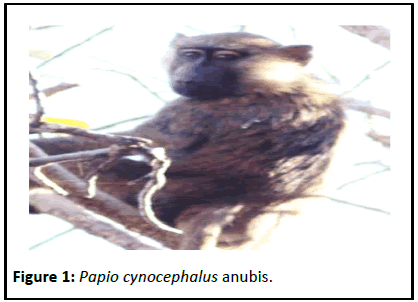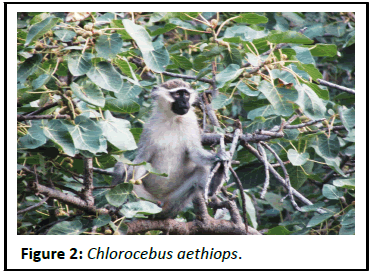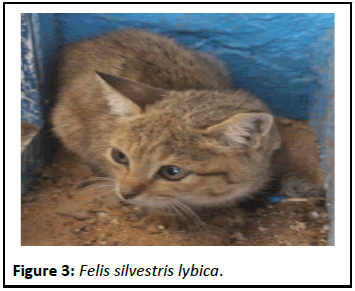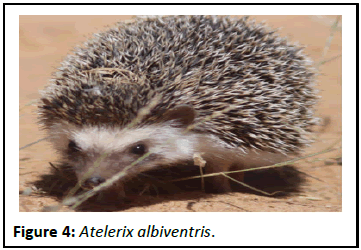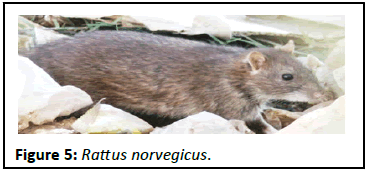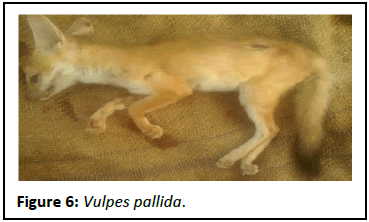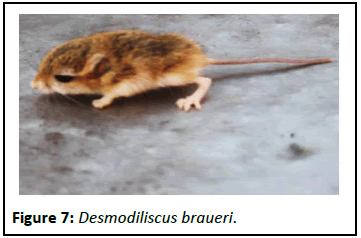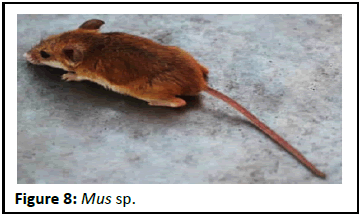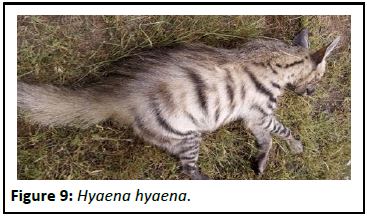ISSN : 2348-1927
Annals of Biological Sciences
Diversity, Distribution and Uses of Wild Mammals of Jebel Al Dayer Biosphere Reserve
Mohmed A Abd El-Rahman1, Zuheir N Mahmoud2* and Mohamed AA Salih1
1Department of Zoology, University of Khordofan, El-Obeid, Sudan
2Department of Zoology, University of Khartoum, Khartoum, Sudan
- *Corresponding Author:
- Zuheir N Mahmoud
Department of Zoology,
University of Khordofan,
Khartoum,
Sudan
Tel: 249911300333
E-mail: zuheirnm@hotmail.com
Received date: July 05, 2023, Manuscript No. ABS-22-17054; Editor assigned date: July 07, 2023, PreQC No. ABS-22-17054 (PQ); Reviewed date: July 21, 2023, QC No. ABS-22-17054; Revised date: March 26, 2024, Manuscript No. ABS-22-17054 (R); Published date: April 02, 2024, DOI: 10.36648/2348-1927.12.2.125
Citation: El-Rahman MAA, Mahmoud ZN, Salih MAA (2024) Diversity, Distribution and Uses of Wild Mammals of Jebel Al Dayer Biosphere Reserve. Ann Bio Sci Vol:12 No:2
Abstract
Jebel Al Dayer (3,715 km2) richness and diversity in biota lead to its declaration as a national park in 2010. It became a UNESCO world biosphere reserves in 2017. Its wild mammals comprised 37 species, in 34 genera, 20 families and nine orders. Herbivorous wild mammals Procava capensis, Chlorocebus aethiops, Hystrix cristata and carnivorous ones caracal, Hyaena hyaena and Canis aureus are endangered by the residents who used it as bush meat, for trade in leather and in traditional medicine at the same time. Wildlife mammals attacking livestock (Vulpus pallida and Felis silvestris lybica) or crops (Mellivora capensis and Lemnicomys striatus) are always attacked by man. Most of the species are least concern and/or for which there are no identifiable risks. However, Gazella dorcas are vulnerable and H. hyaenas are threatened. The least signicant differences showed (p>0.05 to p<0.05) in number of wild mammals between seasons and elevations and between seasons and habitat.
Keywords
Biosphere; Mammalians; Wild; Conflicts; H. hyaenas
Introduction
Jebel Al Dayer Biosphere Reserve (JDBR) is one of the few areas with rich biodiversity in the semi-arid region of North Kordofan. It is composed of dry savannah woodland, forest ecosystems with five permanents and nine temporary streams. There are 16 major and 46 miner villages in JDBR. The climate of the biosphere is characterized by two extremes of dry and wet seasons. The rains start in early April and peaks in August. In the region it is in the range of 412.6 to 489 mm/year [1]. Over 112 plant species in JDBR have been recorded, including 95 species of medicinal and aromatic plants in different ecosystems. The vegetation in the biosphere is typical Sudanian woodland type. The major tree species in the biosphere is dominant by deciduous trees including Boswellia papyrifera, Dichrostachys cinerea, Acacia tortilis, A. mellifera, A. etbaica, Anthephora hochstetteri, Combretum glutinosum, Terminalia spp. and bamboos most of these plant species are not found elsewhere in North Kordofan. The habitat of the biosphere is classified into: Semi-arid mountain peaks woodland savannah urban area mountain forest/slope and agriculture plots [2].
The area was declared as a national park on 25th of July 2010 by the presidential decree no. 196. Its total surface area is 6,374 km2 with a buffer zone of 987 km2 and its transition area is 3,715 km2. In 14 June 2017 it was added to UNESCO world network of biosphere reserves.
JDBR lies between 12°26' and 12°44'N and 30°39', 30°65'E in North Kordofan state (Map 1) [3]. According to Whiteman it is a volcanic rock mountain with different height peaks. It rises over 1,000 m above the surroundings train and 1,451 m.a.s.l.
According to list of mammals of Sudan at least there is about 230 species of mammal falling in 14 orders with rodentia and chiroptera being represented by 46 species each? Happold, et al. recorded 36 species of wild mammals from jebel mara and added 7 species to the region: Mastomys natalensis, Hystrix cristata, Vulpes pallida, Ammotragus lervia, Sylvicapra grimmia and Herpestes spp. [4].
Abdelhamid, reported Papio cynocephalus anubis, Chlorocebus aethiops, Gazella dorcas, Tragelaphus strepsiceros, Mellivora capensis, Heteroharx bruceei, Heliosciurus garianus, Ichneumia herpestes and a Lepus sp., from JDBR. According to IFAD wild mammal of JDBR included T. strepsiceros, Madoqua saltiana, Caracal, Felis silvestris, Crocuta crocuta, Genetta genetta, Papio anubis, Procavia capensis, Erythocebus patas and Cholorocebus aethiops.
Tomor and Hashim, et al. assessed the status of some wild mammal species in dinder national park. El Khidir and Ali used a questionnaire to track 25 wildlife animal species in radom national park from 1974 to 2016. Recent studies on wild mammals in African included the work of Lavrenchenko, et al. which listed 28 species of shrews known from Ethiopia [5]. The wild mammals were studied in Uganda by Mills, et al. in Nepal Shuklaphanta national park by Poudyal, et al. and in Kafa biosphere reserve of Ethiopia by Yonas, et al.
This work aimed to study the dive rsity, distribution and threats to wild mammals other than bats in JDBR.
Materials and Methods
Collection of wild mammals
The wild mammals were seen or recognized by a binocular of the type (Bushnell 16 x 52 66 m 8000 m) [6]. Traps (28 iron meshed traps of different dimensions 18 x 32 x 18; 59 x 32 x 31; 23 x 15 x 12 and 108 x 78 x 78 cm) were baited and used to collect small wild mammals. A tranquilizer gun was used to immobilize large wild mammals (with permission from the authorities of JDBR). Collected wild mammals were photographed using a Samsung grand 2 mobile and a digital Canon camera fitted with a zoom lens 450 mm 800 mm.
Identification and documentation
Identification followed Tilde, 2008 and Jonathan, 2015. The captured specimens were released at site of collection [7]. The study started from 15/10/2021 to 20/10/2022 and covered winter, summer and autumn. The fieldwork extended for 40 days during each season. Wild mammals were counted on basis of season, elevation and habitat type.
Indigenous knowledge
Indigenous knowledge was used to generate a preliminary list of wild mammal species. After alerting the local community in JDBR with the objectives of the questionnaire, 47 forms were distributed randomly and recollected after being filled [8].
Statistical analysis
The Least Sigficance Difference (LSD) was used to compare the means following completely randomized block design analysis.
Results
A total of 1,874 wild mammals belonging to 37 species, 34 genera, 18 families and nine orders were encountered in JDBR (Figures 1-9).
Twenty six species were found in all seasons. Leptailurus serval, E. patas, M. mungo, Atelerix sp. and G. microtis were reported in autumn. Single specimens of M. capensis and of O. afer were encountered during winter. A single specimen of L. microtis was found during summer [9]. The highest number recorded for a wild mammal species was 429 for D. braueri. Wild mammals seen around villages of Sidrah were 82, near Kondukor were 58, close to Farla were 47, and around Negaiaa were 42 and 36 in the vicinity of El Eain as well as in Taiba. The highest recorded number of species was (30%) in the southern of JDBR.
It is apparent from Table 1 that eight species were found in all elevations, five species were observed only in <5 m elevation and 15 species are confined to >500 m elevations.
Procavia capensis and M. natalensis were found in all habitats. Galago senegalensis was observed only on mountain. Papio cynocephalus anubis, C. aethiop, S. grimia, C. aureus were confined to woodland savannah and agricultural plots. Vulpes pallida was observed in semi-arid zones and agricultural plots. Mungos mungo, O. afer, L. microtis, G. micro is and M. capensis were confined to woodland savannah (Table 1). The frequency of specimens of wild mammals sighted in mountain peaks were 94, semi-arid zones reached 549, woodland savannah were 336, urban areas were 164, mountain forest and slope was 321 and in agriculture plots were 347 [10].
Most of the species are at least concern and/or for which there are no identifiable risks. However, G. dorcas are vulnerable and H. hyaenas are near threatened.
| Species | Season | Elevation in m | Habitat | ||||||||||
|---|---|---|---|---|---|---|---|---|---|---|---|---|---|
| Winter | Summer | Autumn | 0-5 | >5-100 | >100-500 | >500-1200 | SA | MP | WS | UA | MF | AG | |
| Order: Tubulidentata, Family: Orycteropidae | |||||||||||||
| Orycteropus afer | 1 | 0 | 0 | - | - | - | + | 0 | 0 | 1 | 0 | 0 | 0 |
| Order: Hyracoidea, Family: Procaviidae | |||||||||||||
| Procavia capensis | 15 | 13 | 35 | + | + | + | + | 6 | 9 | 2 | 11 | 11 | 24 |
| Order: Primates, Family: Galagidae | |||||||||||||
| Galago senegalensis | 3 | 2 | 5 | + | + | + | + | 2 | 0 | 0 | 0 | 8 | 0 |
| Order: Primates, Family: Cercopithecidae | |||||||||||||
| Papio cynocephalus anubis | 51 | 17 | 56 | + | + | + | + | 13 | 0 | 0 | 0 | 83 | 28 |
| Chlorocebus aethiops | 34 | 29 | 45 | + | + | + | + | 36 | 0 | 0 | 0 | 61 | 11 |
| Erythrocebus patas | 0 | 0 | 25 | + | + | + | + | 16 | 0 | 0 | 0 | 0 | 9 |
| Order: Rodentia, Family: Hystricidae | |||||||||||||
| Hystrix cristata | 9 | 3 | 2 | + | + | + | + | 2 | 0 | 3 | 0 | 9 | 0 |
| Order: Rodentia, Family: Sciuridae | |||||||||||||
| Xerus erythropus | 43 | 27 | 9 | + | + | - | - | 0 | 43 | 27 | 0 | 0 | 9 |
| Xerus rutilis | 4 | 2 | 3 | + | - | - | - | 0 | 4 | 2 | 0 | 0 | 3 |
| Order: Rodentia, Family: Gliridae | |||||||||||||
| Graphiurus microtis | 0 | 0 | 1 | - | - | + | + | 0 | 0 | 1 | 0 | 0 | 0 |
| Order: Rodentia, Family: Dipodidae | |||||||||||||
| Jaculus jaculus | 10 | 4 | 7 | - | - | - | + | 0 | 10 | 4 | 0 | 0 | 7 |
| Desmodiliscus braueri | 123 | 119 | 87 | - | - | - | + | 0 | 123 | 119 | 2 | 0 | 85 |
| Gerbillus gerbillus | 25 | 12 | 3 | - | - | - | + | 0 | 25 | 12 | 0 | 0 | 3 |
| Mastomys natalensis | 134 | 94 | 111 | - | + | + | + | 33 | 101 | 41 | 53 | 39 | 72 |
| Arvichanthis niloticus | 176 | 30 | 49 | - | - | - | + | 0 | 81 | 28 | 2 | 91 | 53 |
| Acomys cahirinus | 4 | 1 | 0 | - | - | - | + | 0 | 4 | 1 | 0 | 0 | 0 |
| Aethomys hindei | 7 | 0 | 4 | - | - | - | + | 0 | 2 | 4 | 0 | 0 | 5 |
| Lemnicomys striatus | 11 | 0 | 4 | - | - | - | + | 0 | 11 | 0 | 0 | 0 | 4 |
| Order: Lagomorpha, Family: Leporidae | |||||||||||||
| Lepus capensis | 18 | 15 | 27 | + | - | - | - | 0 | 18 | 15 | 0 | 27 | 0 |
| Lepus microtis | 0 | 1 | 0 | + | - | - | - | 0 | 0 | 1 | 0 | 0 | 0 |
| Order Erinaceomorpha, Family: Erinaceidae | |||||||||||||
| Atelerix albiventris | 9 | 7 | 15 | + | - | - | - | 9 | 0 | 7 | 0 | 15 | 0 |
| Order: Soricomorpha, Family: Soricidae | |||||||||||||
| Crocidura spp. | 6 | 5 | 11 | + | - | - | - | 0 | 6 | 5 | 0 | 10 | 1 |
| Order: Carnivora, Family: Felidae | |||||||||||||
| Caracal caracal | 1 | 8 | 2 | + | + | + | + | 1 | 0 | 8 | 0 | 2 | 0 |
| Felis silvestris lybica | 23 | 9 | 14 | - | + | + | + | 23 | 0 | 9 | 0 | 14 | 0 |
| Leptailurus serval | 0 | 0 | 2 | - | + | + | - | 0 | 0 | 0 | 0 | 2 | 0 |
| Order: Carnivora, Family: Viverridae | |||||||||||||
| Genetta genetta | 19 | 6 | 13 | - | - | + | + | 0 | 3 | 16 | 4 | 0 | 15 |
| Order: Carnivora, Family: Herpestidae | |||||||||||||
| Herpestes sanguineus | 3 | 1 | 3 | - | - | - | + | 3 | 0 | 1 | 0 | 3 | 0 |
| Herpestes ichneumon | 2 | 0 | 0 | - | - | - | + | 0 | 0 | 2 | 0 | 0 | 0 |
| Ichneumia albicauda | 7 | 3 | 2 | - | - | - | + | 7 | 0 | 2 | 0 | 3 | 0 |
| Mungos mungo | 0 | 0 | 6 | - | - | - | + | 0 | 0 | 6 | 0 | 0 | 0 |
| Order: Carnivora, Family: Hyaenidae | |||||||||||||
| Crocuta crocuta | 0 | 1 | 2 | - | + | + | + | 0 | 0 | 1 | 0 | 2 | 0 |
| Hyaena hyaena | 2 | 5 | 12 | - | - | + | + | 2 | 0 | 5 | 0 | 12 | 0 |
| Order: Carnivora, Family: Canidae | |||||||||||||
| Vulpes pallida | 9 | 7 | 9 | - | - | + | + | 0 | 9 | 0 | 0 | 0 | 16 |
| Canis aureus | 4 | 1 | 2 | - | - | - | + | 0 | 0 | 2 | 0 | 0 | 5 |
| Order: Carnivora, Family: Mustelidae | |||||||||||||
| Ictonyx striatus | 4 | 4 | 7 | - | - | - | + | 0 | 0 | 6 | 2 | 0 | 7 |
| Mellivora capensis | 1 | 0 | 0 | - | - | - | + | 0 | 0 | 1 | 0 | 0 | 0 |
| Order: Artiodactyla, Family: Bovidae | |||||||||||||
| Tragelaphus strepsiceros | 4 | 5 | 15 | + | + | + | + | 9 | 0 | 0 | 1 | 12 | 2 |
| Sylvicapra grimmia | 0 | 3 | 3 | + | + | + | - | 0 | 0 | 2 | 0 | 0 | 4 |
| Note: Semi-Arid: SA; Mountain Peaks: MP; Woodland Savannah: WS; Urban Area: UA; Mountain Forest/slope: MF; Agriculture plots: Ag. | |||||||||||||
Table 1: Distribution of wild mammals in JDBR according to season, elevation and habitat.
The distribution of wild mammals according to season and elevation was assessed by LSD which showed (p>0.05 to p<0.05) in numbers between seasons and elevations, and between seasons and habitat (Table 2) [11].
| Elevation in m | Season | Total | Mean | ||
|---|---|---|---|---|---|
| Winter | Summer | Autumn | |||
| 0-5 | 709 | 359 | 477 | 1545 | 509a |
| >5-100 | 73 | 27 | 49 | 149 | 49.67b |
| >100-500 | 38 | 25 | 32 | 95 | 31.67b |
| >500-1200 | 28 | 24 | 26 | 78 | 26b |
| Total | 848 | 435 | 584 | 1867 | |
| Mean | 212a | 108.75c | 146b | ||
| Note: Means with different superscripts in a raw and in a column are significantly (p<0.05) different. | |||||
Table 2: Distribution according to season and elevation.
The distribution of wild mammals according to season and elevation was assessed by LSD which showed (p>0.05 to p<0.05) in numbers between seasons and elevations, and between seasons and habitat (Table 3).
| Habitat* | Season | Total | Mean | ||
|---|---|---|---|---|---|
| Winter | Summer | Autumn | |||
| SA | 233 | 131 | 177 | 541 | 135.25a |
| MP | 70 | 41 | 42 | 153 | 38.25b |
| WS | 127 | 69 | 127 | 323 | 80.75b |
| UA | 64 | 43 | 57 | 164 | 41.0b |
| MF | 146 | 59 | 73 | 278 | 69.5b |
| Ag | 208 | 92 | 108 | 408 | 102.0a |
| Total | 848 | 435 | 584 | 1867 | |
| Mean | 169.6a | 87b | 116.8ab | ||
| Note: *See legends of Table 1. Means with different superscripts in a raw and in a column are significantly (p<0.05) different. |
|||||
Table 3: Distribution according to season and habitat.
Wild mammals uses by residents of JDBR
Nine species of wildlife were used as food, in traditional medicine and decoration trade (Table 4) [12]. The total number of species used only as food, or in decoration or in traditional medicine were 21, 15 and 14, respectively.
| Scientific name | Exploited for | ||
|---|---|---|---|
| Food | Traditional medicine | Decoration | |
| Herbivores mammals | |||
| Procava capensis | 5 | 13 | 1 |
| Erythrocebus patas | 4 | 0 | 0 |
| Chlorocebus aethiops | 2 | 1 | 4 |
| Papio. c. annubis | 12 | 13 | 0 |
| Hystrix cristata | 18 | 28 | 2 |
| Xerus rutilis | 21 | 3 | 1 |
| Xerus erythropus | 1 | 0 | 0 |
| Jaculus jaculus | 1 | 0 | 0 |
| Arvichanthis niloticus | 4 | 0 | 0 |
| Lepus capensis | 14 | 7 | 3 |
| Atelerix albiventris | 3 | 0 | 0 |
| Gazella dorcas | 18 | 0 | 3 |
| Tragelaphus strepsiceros | 17 | 0 | 2 |
| Sylvicapra grimmia | No record | ||
| Carnivorous mammals | |||
| Caracal caracal | 3 | 3 | 1 |
| Felis silvestris lypica | 7 | 0 | 7 |
| Genetta genetta | 2 | 0 | 1 |
| Leptailurus serval | 0 | 0 | 3 |
| Ichneumia albicauda | 0 | 1 | 0 |
| Crocuta crocuta | 3 | 3 | 0 |
| Hyaena hyaena | 1 | 2 | 1 |
| Vulpes pallida | 3 | 0 | 0 |
| Canis aureus | 3 | 2 | 2 |
| Mellivora capensis | 0 | 3 | 0 |
Table 4: Wild mammal species of known uses by residents in JDBR.
Most risks stem from conflicts between man and wild mammals. These are: Bush meat of herbivorous like P. capensis, C. aethiops, H. cristata and carnivorous like C. caracal, H. hyaena and C. aureus wild mammals attacking livestock (V. pallida and F. s. lybica) or crops (M. capeinsis and L. striatus) led to destruction of burrows by the residents non-intention knock down by vehicles entail J. jaculus, A. albiventris and D. braueri. Unintentional fires represent unexpected risks to the flora and wildlife in JDBR [13]. The growing interest in building material increased burrow destruction rates due to mechanical deriding, as well as road accidents and bush meat exploitation (Table 3). The negative impacts on wild mammal’s entails seven species attacking domestic animal in 44 accidents; 14 species share pasture and/or feed on crops in 177 accidents. Human impact included killing of 4 wild mammals to protect domestic animals in 4 accidents destruction of burrow of 12 species in 62 accidents in 10 road acidents 3 species were killed and 55 cases of bush meat involved 16 species (Table 5) [14].
| Species | Wildlife impact | Human impact | ||||||
|---|---|---|---|---|---|---|---|---|
| ADA | SPL | FFC | KM | DB | RA | IP | ||
| Total of accidents | 34 | 4 | 173 | 4 | 62 | 10 | 55 | |
| Total of species | 7 | 2 | 12 | 4 | 12 | 3 | 16 | |
| Note: Attack Domestic Animal: ADA; Share Pasture with Livestock: SPL; Feed on Farm Crops FFC; Killed by Man: KM; Destruction of Burrow: DB; Road Accidents: RA; Illegal Poaching: IP. | ||||||||
Table 5: Conflicts of wildlife and man in JDBR.
The set questionnaire was intended to generate data on the attitude of the local names of wildlife and their consumptive uses, frequency of sighting wildlife by age groups, and the nature of conflicts outlined between man and wildlife [15].
The frequency of sighting wildlife in JDBR by age groups (5-15), (16-25) and (26-35) was more than age groups (36-45) and (>46). This might be attributed to differences in activity between these age groups.
Discussion
Jebel Al Dayer biosphere reserve is the richest biodiversity area in North Kordofan. Five permanent and 9 temporary streams run through it. Recorded over 112 plant species including 95 species of medicinal and aromatic plants in JDBR.
The present study collected 1,874 specimens of wild mammals. These belonged to 40 species, 36 genera, 20 families and? Orders in JDBR [16].
The IUCN recorded 188 wild mammal species in Sudan, of which three are critically endangered, ive are endangered, 11 are vulnerable and nine are near threatened [17]. This list needs to be updated a ter separation of Southern Sudan. Most of the mammalian species found in JDBR during this study like G. gerbillus, Crocidura sp., M. natalensis, A. niloticus, C. aethiops, A. albiventris and C. pumil are least concern and/or for which there are no identifiable risks. However, G. dorcas is vulnerable and H. hyaena are near threatened.
The present study encountered? wild mammal species in JDBR. Abdelhamid, et al. reported P. c. anubis, C. aethiops, G. dorcas, T. strepsiceros, M. capensis, H. bruceei, H. garianus, I. herpestes and a Lepus sp. However, H. bruceei and H. garianus were not encountered during this study. On the other hand, Ichneumia herpestes does not exist as a species and probably it was a miss identification by Abdelhamid. According to Wozencraft the species Albicauda is the only member of the genus Ichneumia. IFAD encountered from JDBR T. strepsiceros, M. saltiana, C. caracal, F. silvestris, C. crocuta, G. genetta, P. anubis, P. capensis, E. patas and C. aethiops. The present study confirmed IFAD findings. Hashim and Mahgoub recorded A. niloticus, Crocidura sp., I. albicauda, H. ichneumon, G. genetta, L. serval, M. capensis, G. senegalensis, H. cristata, X. erthropus, A. cahirinus, H. cristata and O. afer in Dinder national park. Mahmoud found the following mammals from the six cataract area: Herpestes ichneumon, G. gerbillus, Crocidura sp., M. musculu, A. niloticus and C. pumila. These were also found in JDBR during this study.
Some wild mammals are difficult to access. For example, G. senegalensis is a small nocturnal primate that can only be detected by a hand torch or a head torch [18]. The banded mongoose Mungo uses various types of shelters including termite mounds.
In the Dinder National Park (DNP) 60% of the mammals seen were P. c. anubis Tomor, et al. In DNP the most abundant small mammal was common genet and the least was the fox Hashim, et al. In JDBR the most abundant among wild mammals was R. microphylum, and the least abundant were M. capensis, Atelerix sp., L. micro is, G. micro is, O. afer, C. afra and D. braueri. Desmodiliscus braueri was found in Sahelian steppes on sandy or gravelly soils from Mauritania to Sudan, vicinity of Khartoum Jonathan, et al. Xerus rutilus and L. striatus were recorded in Southern Tanzania Nkwabi, et al. The least signicant differences showed (p>0.05 to p<0.05) in number of wild mammals between seasons and elevations, and between seasons and habitat.
Strong conflict was observed by Gataro and Tekalign between P. c. anubis and the people in southern Ethiopia [19]. Human settlement inside radom national park led to migration of some wildlife species due to loss of their habitats.
The present study identified the following pattern of conflicts between wildlife and man in JDBR. Seven species of wild carnivores attacked domestic animal in 34 accidents [20]. In 173 cases 12 species of wild herbivores were found feeding on crops. Four species were shot by man in 4 accidents to defend domestic animals. Destruction of burrow by man in 62 cases impacted 12 species ten road accidents entailed three species. Bush meat targeted 16 species in 55 cases.
In JDBR 9 species of wildlife were used as food, in traditional medicine and decoration trade [21]. The total number of species used only a food, or in decoration or in traditional medicine were 20, 15 and 14, respectively. On the other hand, 53 species were found to be of no known use.
Conclusion
This baseline study of wildlife mammal’s species in JDBR concluded that: Most of the wildlife species found are least concern and/or for which there are no identifiable risks. Gazella dorcas is vulnerable and P. regius, P. sebae and H. hyaena are near threatened. Among non-flying mammals was D. braueri was the most abundant and M. capensis, Atelerix sp., L. micro is, G. micro is, O. afer, C. afra and D. braueri were the least abundant non-flying mammals in JDBR. Awareness among the residents of JDBR of the benefits that can be gained from protection of their wildlife is a priority.
Increase patrolling rates by employing modern techniques such as enough camera traps, camera drones and VHF radios to monitoring wildlife movement and risks.
Ethics Approval, Consent to Participate and Publish, Human and Animal Rights, Availability of Data and Materials
Not applicable.
Conflict of Interest
The authors declare no conflict of interest, financial or otherwise.
Acknowledgement
The Directorate of Jebel Al Dayer biosphere reserves are greatly acknowledged for the work permit and for hospitality.
References
- Abdelhamid SM (2000) Assessment of biodiversity in J. Ed Dayer, North Kordofan, WRC Report. 7.
- Ahmed SE (2021) Birds Fauna of Jebel El Dayer National Park-Sudan, Israa University. J Appl Sci. 5:87-101
- El Khidir AA, Ali OM (2018) The impact of war on wildlife in radom national park, Southern Darfur State-Sudan. J Biodivers Endanger Species 6:2-8
- El-Obeid meteoroidal station (2023) Meteoroidal data of North Kordofan.
- Gataro T, Tekalign W (2021) The attitude of people towards Anubis baboon (Papio anubis) crop foraging activities in sub-Saharan Africa, southern Ethiopia. Primates 62:563-570
[Crossref] [Google Sholar] [PubMed]
- Happold DCD (1967) Additional information on the mammalian Fauna of the Sudan. Extrait De Mammalia 606-608.
- Harper EB, Measey GJ, Patrick DA, Menegon M, Vonesh JR, et al. (2010) Field guide to the amphibians of the Eastern Arc Mountains and Coastal Forests of Tanzania and Kenya. Camerapix Publishers International, Nairobi, Kenya. 114
- Hashim IM, Mahgoub KS (2008) Abundance, habitat preference and distribution of small mammals in Dinder National Park, Sudan. Afr J Ecol 46:452-455
- IFAD and Police of protected wildlife (2008) Jebel El Dayer Management Wildlife Natural Resources.
- IUCN (2001) "The IUCN red list of threatened species: Mammals of Sudan". International union for conservation of nature.
- Lavrenchenko LA, Voyta LL, Hutterer R (2016) Diversity of shrews in Ethiopia, with the description of two new species of Crocidura (Mammalia: Lipotyphla: Soricidae). Zootaxa 4196:38-60
[Crossref] [Google Sholar] [PubMed]
- Mahmoud ZN (2023) A Guide to Field Work: The Sabaloka area as a Model. In Press.
- Mills DR, Do Linh San E, Robinson H, Isoke S, Slotow R, et al. (2019) Competition and specialization in an African forest carnivore community. Ecol Evol 9:10092-10108
[Crossref] [Google Sholar] [PubMed]
- Nkwabi AK, John B, Kija H, Otsyina RM, Monjare JF, et al. (2018) Abundance and distribution of small mammals relative to human activities in the wildlife management areas of Ruvuma landscape, southern Tanzania. Int J Fauna Biol Stud 5:156-162
- Poudyal LP, Lamichhane BR, Baral HS, Basnet H (2020) Wild mammals of the Shuklaphanta National Park. Publisher Shuklaphanta National Park and Himalayan Nature. Nepal Office and Himalayan Nature, Kanchanpur and Kathmandu, Nepal.
- Setzer HW (1956) Mammals of The Anglo-Egyptian Sudan, Proceedings of the United State National Museum, Smithsonian Institution, United States national museum Washington, DC. 106:448-583
- Tilde CS (2008) Field guide to the larger mammals of Africa. 3rd edition. International Pub Marketing. 320
- Tomor BM (2006) Assessment of the status of some mammalian species in Dinder National Park using 'kilometric' index as a measure of abundance. J Argic Sci 14:275-288
- Whiteman AJ (1971) Geology of the Sudan Republic. Clarendon Press.
- Wozencraft WC (2005) Mammal Species of the World: A Taxonomic and Geographic Reference. (3rd edition). Johns Hopkins University Press. 562.
- Meheretu Y, Meinig H, Mikula O, Hermes N, Wale M, et al. (2022) Small-and medium-sized mammals of the Kafa Biosphere Reserve, Ethiopia. Afr J Ecol 60:433-446
Open Access Journals
- Aquaculture & Veterinary Science
- Chemistry & Chemical Sciences
- Clinical Sciences
- Engineering
- General Science
- Genetics & Molecular Biology
- Health Care & Nursing
- Immunology & Microbiology
- Materials Science
- Mathematics & Physics
- Medical Sciences
- Neurology & Psychiatry
- Oncology & Cancer Science
- Pharmaceutical Sciences
